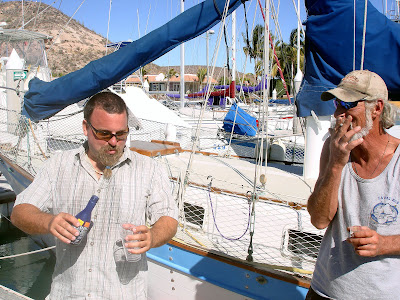The story of our third journey on the
S/V Estrella began with picking up our good friends Sheila and Teal at the Cabo San Lucas airport. Having spent the winter thus far in Olympia, Washington, they were anxious to work on their tans, swim in water above 55F, and consume many beers and fish tacos. We made sure to find them a quiet beach for swimming in the Sea of Cortez approximately one hour after their plane touched down.

After two days of acclimating to the Mexican winter sunshine and exploring La Paz and it's drivable beaches, we headed to sea with Sheila and Teal on the
S/V Estrella. Our three night trip began with a sail in light winds to Bahia San Gabriel on Isla Espiritu Sanctu. Sheila and Teal are both experienced hands at sailing and were soon right at home tending lines and sails.

We relaxed our first night at sea in Bahia San Gabriel as Sheila and Teal cooked homemade soft pretzels and hot buttered rum for dinner. Sheila went for a night swim around the boat and with the phosphorescence in the water and lack of moon, she looked like an aquatic angel of sorts.
The following morning we embarked on a four mile hike across Isla Espiritu Sanctu to Playa Bonanza. This was a new hike for everyone and we were looking forward to the adventure of making our own trail across the island. Part of an established trail existed but the pieces we found were not interconnected in any fashion.

As we headed across the island, the
S/V Estrella grew further and further away amongst the cacti.

Facing away from Bahia San Gabriel, one would think we were heading into the Arizona desert as Playa Bonanza was not visible for another three miles into the hike.

We found many living cacti intertwined with dead cactus wood.

The terrain elevated slightly during the hike and the flora changed toward underbrush and agave-dominate. The seed pods in the photo above are from an agave plant with a ten foot tall seed stalk. The plant put out the stalk and seed pods before dying.

We reached Playa Bonanza at last after a mild hike through the underbrush and cacti of Isla Espiritu Sanctu. The most rewarding aspect was the swim at the end at Playa Bonanza!
After our hike and swim, we turned around and headed back to Bahia San Gabriel for lunch and beers on
S/V Estrella. We pulled up the anchor after lunch and headed north along Islas Espiritu Sanctu and Partida. There was no wind to speak of and we motored up to our next anchorage, Ensenada Grande. The anchorage was virtually empty except for a few sailboats and we spent the remainder of the day relaxing and playing endless cribbage.
From Ensenada Grande, we were perfectly staged to visit the California sea lion colony at Los Islotes. This rookery is an old stomping ground for Josh and I but for Sheila and Teal, it was a brand new experience. The wind was blowing hard from the south (strange for winter in the Sea of Cortez) so we dropped Sheila and Teal on the north side of the island for their snorkel with the sea lions. They were two of many snorkelers in the water but enjoyed their time with the sea lions and the abundant fish and coral on the north side of Los Islotes.
We next sailed down the east side of the islands to our last anchorage, Playa Bonanza. The wind switched around briefly to allow us to put up all our sails. The marine life was spectacular from the sailboat as bottlenose dolphins followed us for almost two hours. We also saw manta rays jumping and a green sea turtle just outside Playa Bonanza. Sheila caught a Pacific bonita on our brand new fishing rod just before we dropped the anchor.

We were concerned that her fish wouldn't be enough to feed the four of us sufficiently. So following an afternoon at snorkeling at Playa Bonanza, we cooked up her fish in conjunction with a giant bowl of garlic mashed potatoes. The fish was surprisingly tasty and each of us were able to enjoy a minor fillet with our potato dinner.
Note: Sheila is approximately six feet in height so the fish is larger than in appears.
The wind kicked at sunset from the north so our sail in the following day was a downwind leg in modest swells. We made marvelous time as we headed back into La Paz and didn't turn the motor on until we were physically inside the marina. We had good reason to celebrate our fabulous trip with a delicious lunch of tacos de pescado, buckets of beer, and mariachi music.
What a way to end our third trip!






















